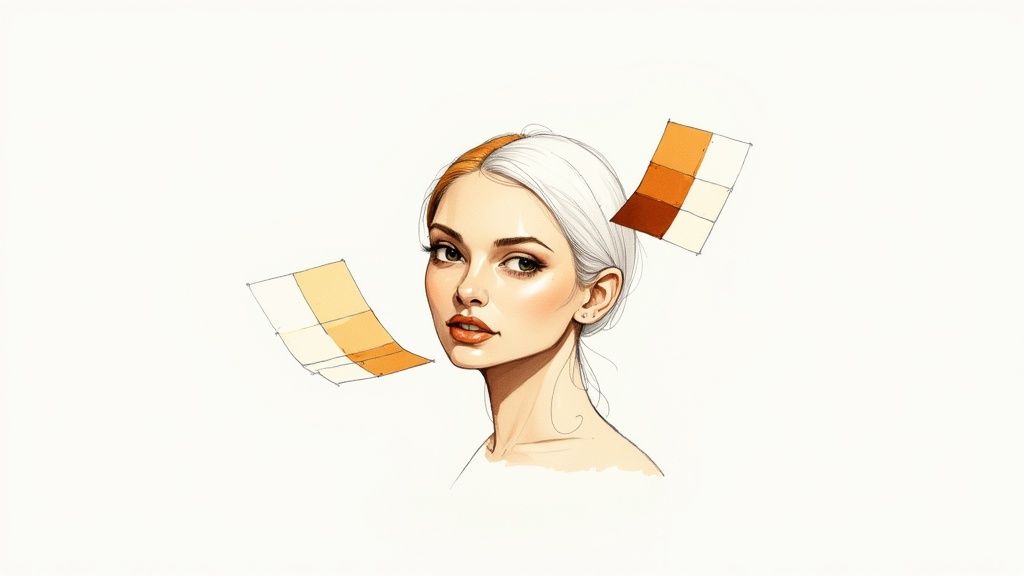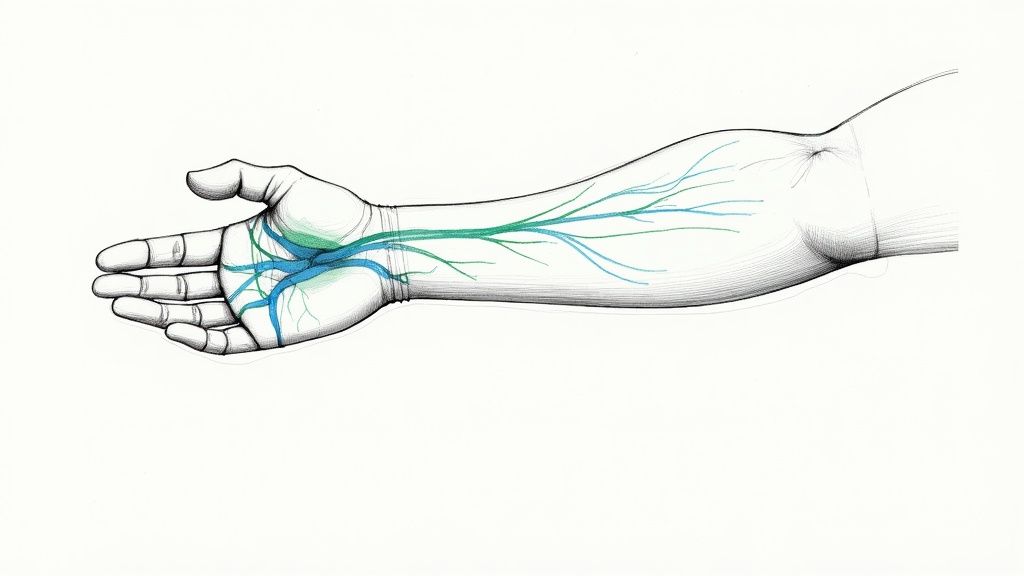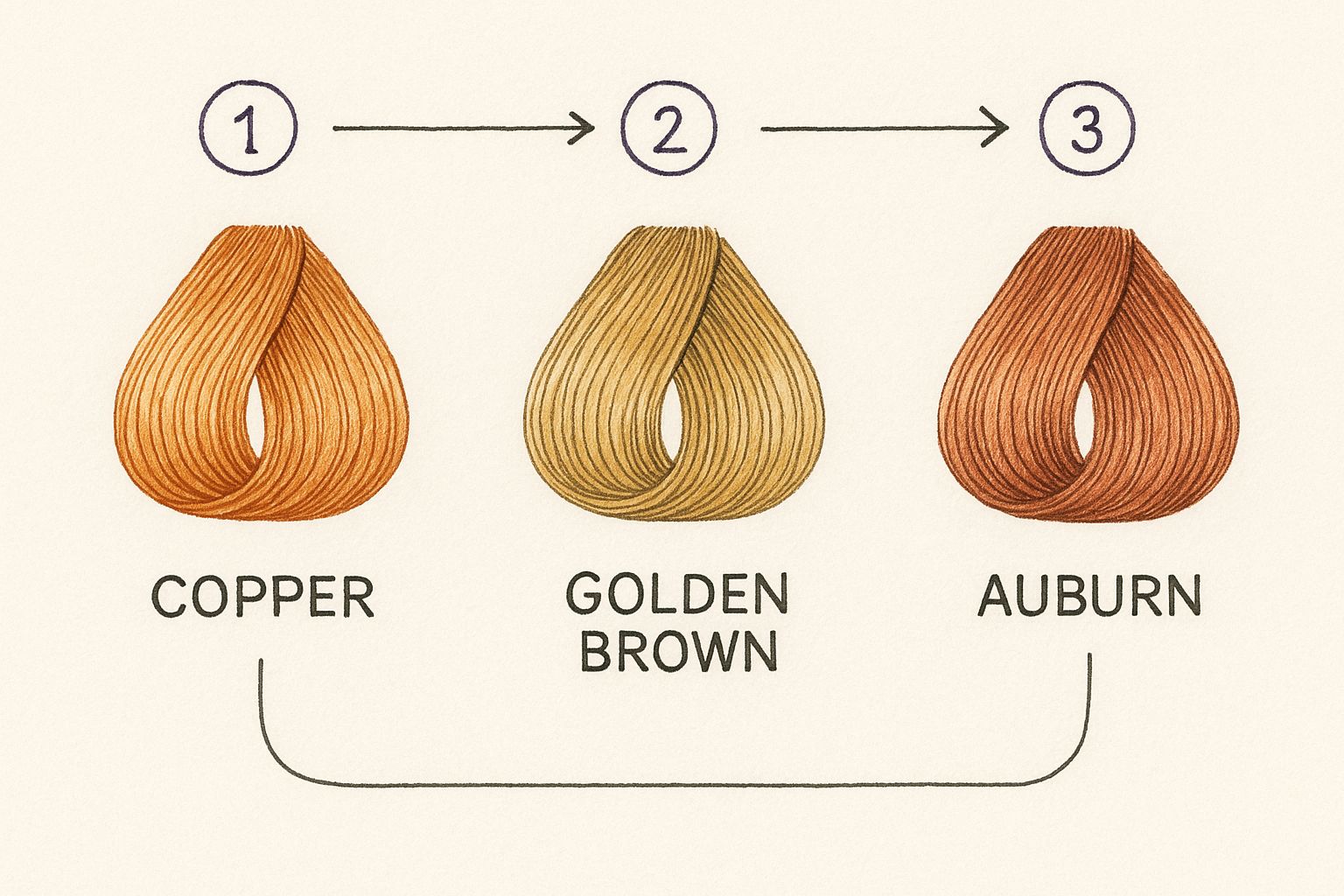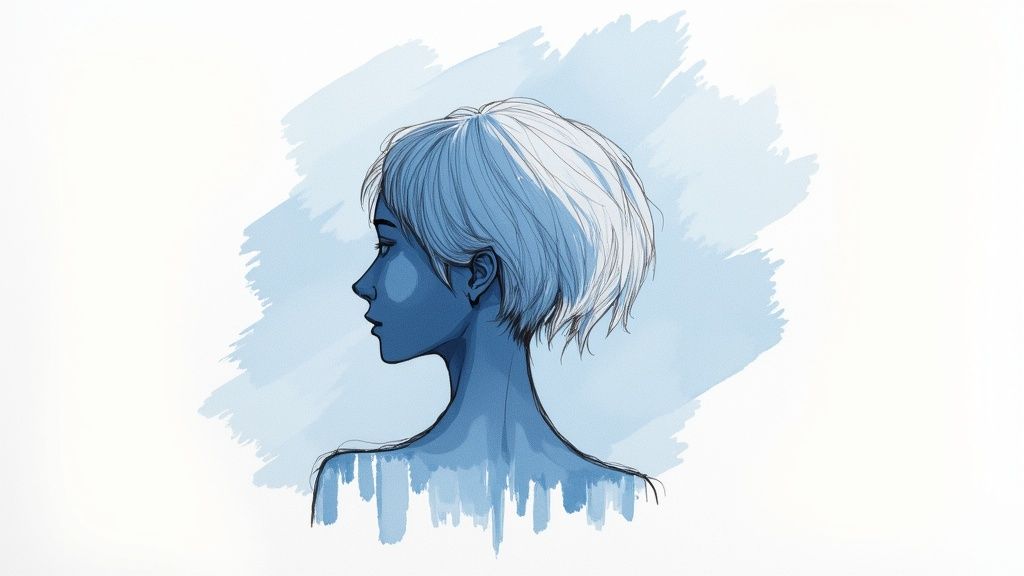
Discover the Best Hair Color for My Skin Tone Today
By Emma Johnson - 10/8/2025
The real secret to finding the best hair color for your skin tone isn't about what's trendy—it's about understanding the subtle hues just beneath your skin's surface. Your perfect shade works in harmony with your unique undertone, whether it's cool, warm, or neutral, to light up your features for a look that's effortlessly stunning.
Your Guide to Finding the Perfect Hair Color
Picking a new hair color can feel overwhelming, but it doesn't have to be. It’s about more than just finding a pretty shade; it's about discovering the colors that genuinely flatter you. This guide is here to cut through the confusion and help you make a choice you'll love.
We’ll focus on the two things that matter most: your skin’s surface tone (like fair, medium, or deep) and, most importantly, its undertone (cool, warm, or neutral). Once you nail this, you’ll know exactly why certain colors make you glow.
Instead of just saving endless inspiration photos, you'll learn the "why" behind what works. We'll walk through a few simple, real-world tricks to identify your undertones. Armed with that knowledge, you can confidently choose shades that make your best features pop.
Matching Color to Your Complexion
This concept of matching color to skin tone isn't just a styling trick; it’s a global principle. The worldwide hair color market, valued at a staggering USD 26.85 billion, is built on this very idea. Consumer preferences are deeply connected to skin tone and cultural aesthetics.
You can see this play out across different regions. In Northern Europe, where lighter skin is common, cool ash-blondes and striking platinum shades are a natural fit. Contrast that with Southern Europe and parts of Asia, where deeper chestnuts and rich reds beautifully complement Mediterranean or darker complexions. You can dive deeper into these market trends and consumer preferences on Straits Research.
At the end of the day, it's all about creating a sense of harmony.
The goal is to select a hair color that works with your skin, not against it. A well-chosen shade can brighten your eyes, even out your complexion, and give you a healthy, radiant glow.
To get you started, here’s a quick-reference guide that breaks down which color families tend to flatter each undertone. Think of it as your cheat sheet for your next salon visit.
Quick Guide to Hair Color and Skin Undertones
This table offers a snapshot of which hair color families generally work best with cool, warm, and neutral undertones. It’s a great starting point to help narrow down your options.
| Skin Undertone | Best Hair Color Families | Colors to Approach with Caution |
|---|---|---|
| Cool | Ashy Blondes, Platinum, Cool Browns, Burgundy, Blue-Black | Golden Blondes, Coppery Reds, Caramel Browns |
| Warm | Golden Blondes, Honey, Caramel, Auburn, Chocolate Brown | Ashy Tones, Platinum, Blue-Based Reds |
| Neutral | Most shades work well, balanced tones are ideal | Extremely cool or extremely warm shades |
Remember, these are guidelines, not hard-and-fast rules. The most important thing is choosing a color that makes you feel fantastic.

How to Figure Out Your Skin's Undertone
Finding the best hair color for your skin tone isn't about what you see on the surface. It's about a subtle, underlying hue called an undertone, and it's the real secret to picking shades that make you look amazing. Your surface skin tone might change after a week at the beach, but your undertone? That stays with you for life.
You've probably heard about the "vein test," but honestly, it can be pretty misleading. Let's walk through a couple of tried-and-true methods that hairstylists have used for years to pinpoint whether someone has a cool, warm, or neutral undertone. These simple reality checks will give you the confidence you need before you even think about booking that salon appointment.
The Jewelry Test
This is one of the quickest and most reliable tricks in the book, and you can do it right now with jewelry you already own. It works because different metals reflect light in a way that either beautifully complements your skin or kind of clashes with it.
Find a piece of silver jewelry and a piece of gold jewelry. In natural daylight (this part is important!), hold each one up against your skin. Your wrist or the area near your face works best.
- If silver jewelry gives your skin a bright, clear, and healthy look, you almost certainly have cool undertones.
- If gold jewelry makes your skin pop with a warm, sunny glow, you're looking at warm undertones.
- And if you can't decide because both look fantastic? Congratulations, you have a neutral undertone, which means you have the freedom to play with a much wider palette of hair colors.
The White Fabric Test
Here's another great at-home test. This one is all about seeing how your skin reacts when placed next to different shades of white, which really helps expose the subtle pinks, blues, or golden yellows hiding just beneath the surface. You'll need two items: something stark, pure white (like a piece of printer paper) and something off-white or cream-colored (like a vanilla-hued t-shirt).
Stand in front of a mirror in a well-lit room, ideally with natural light. Hold each piece of fabric up to your face, one at a time, and really look at the effect. Does one make you look tired or sallow, while the other brings your features to life?
The right color will make your face look brighter and your complexion more even. The wrong one can cast weird shadows or make your skin look dull and washed out.
If that pure white fabric is your winner, making your skin look crisp and vibrant, your undertones are cool. If the off-white or cream gives you a healthier, more radiant look, your undertones are warm. And if you honestly can't tell much of a difference? You're likely in the versatile neutral camp.
If you want to dig even deeper, we have a complete guide covering even more techniques in our article on the warm vs. cool undertone test.
This infographic is a great visual reference, showing a beautiful gradient of warm-toned hair colors like rich copper, golden brown, and auburn.

For anyone who discovers they have a warm undertone, shades like these are a perfect place to start. They create a look that feels both natural and incredibly flattering.
By trying out these practical tests, you're no longer just guessing. Nailing down your undertone is the single most important step you can take toward choosing a hair color that doesn’t just look good on you—it makes you feel like the most confident version of yourself.
The Best Hair Colors for Cool Skin Tones
So, you’ve done the tests and discovered you have cool undertones—those subtle hints of pink, red, or blue just beneath your skin. Great! This is your starting line for finding a hair color that truly makes you shine.
The secret is to work with your skin, not against it. Your best bet is to stick with shades that have a cool base, like ashy, icy, or neutral tones. This creates a gorgeous, natural harmony that brightens your whole face and makes your best features pop. Get it wrong, and a warm color can leave you looking washed out or even a bit ruddy. Think of it like a stylist choosing the perfect accessories—the right hair color pulls everything together.

Finding Your Perfect Blonde or Brunette
If you're dreaming of going blonde, cool-toned shades are your best friends. You'll want to steer clear of anything too golden, honey, or brassy, as those warm tones can clash with the pink or blue in your skin.
Instead, ask your stylist for one of these stunning options:
- Platinum Blonde: It’s a bold, icy statement that creates an incredibly modern and striking look.
- Ash Blonde: This sophisticated, almost smoky shade is fantastic for neutralizing any redness in your skin.
- Beige Blonde: For a softer, more natural vibe, this neutral-cool color is a beautiful and subtle choice.
Prefer to stay on the darker side? Cool brunettes are perfect for adding incredible depth and richness without introducing that unwanted warmth. Deep espresso and cool-toned dark chocolate look absolutely amazing, especially against fair skin. Also, consider an ash brown, which has a grayish base that complements cool complexions perfectly. For celebrity inspiration, look no further than Anne Hathaway—her signature deep, cool brown hair is a flawless match for her fair, cool-toned skin.
Don't Be Afraid of Red and Bolder Hues
It’s a common myth that people with cool undertones can't pull off red hair. That couldn't be further from the truth! You just have to pick the right kind of red.
Forget the coppery, orange-based shades. Instead, you want to reach for reds that have a blue or purple base. Think deep burgundy, rich auburn, or shades of cherry and wine.
Interestingly, our natural hair colors are often tied to genetics and geography, which also influence our skin tones. For example, only about 1-2% of the world's population are natural redheads, with the highest concentration in Northern Europe. Scotland actually leads the pack, with around 13% of its people rocking red hair—a trait that often goes hand-in-hand with the fair, cool skin common in the region. You can find more fascinating tidbits about hair color stats on All Things Hair.
Want to go for something a little more unconventional? Cool-toned skin is a fantastic canvas for fashion colors. Deep sapphire blue, a dreamy lavender, or even a smoky gray can look incredibly chic and harmonious.
If your seasonal color analysis puts you in a "cool" category like Deep Winter, all these recommendations will align perfectly. You can dive deeper into this with our guide to the Deep Winter color palette. No matter what you choose, the key is always to look for that cool base.
The Best Hair Colors for Warm Skin Tones
So, you’ve figured it out: your skin has warm undertones. You’re seeing those beautiful golden, peachy, or yellow hues, and now you’re ready to find the hair color that makes you look absolutely radiant. The secret is to lean into that natural warmth, choosing shades that echo the richness of your complexion for a truly harmonious look.
Think of your hair as the ultimate accessory for your face. When you pick the right one, everything just clicks. For warm skin, that means choosing colors like rich golds, fiery coppers, and decadent browns. These shades will make your skin look healthy and luminous, whereas cool, ashy colors can leave you looking washed out. Just look at celebrities like Beyoncé and Jennifer Lopez—they’ve perfected the art of using everything from golden honey highlights to rich caramel bases to play up their gorgeous warm complexions.
Golden Blondes and Rich Browns
If blonde is what you're after, think warm and sunny. You'll want to stay away from anything ashy or platinum, as those shades can create a jarring contrast and cast a dull, grayish shadow on your skin. Instead, focus on blondes that have a distinct golden base.
Here are a few fantastic blonde shades to consider:
- Honey Blonde: A classic for a reason. This rich shade brings an incredible amount of warmth and light to your face.
- Caramel Blonde: The perfect choice for creating multi-dimensional, sun-kissed highlights.
- Strawberry Blonde: A beautiful fusion of red and gold that’s especially stunning on fairer warm skin.
- Golden Beige: A softer, more understated option that still has that essential warmth you need.
For those who lean brunette, the same rules apply. You're looking for browns that feel alive and full of dimension, not flat or ashy. Imagine decadent, luxurious colors like a deep chocolate brown, a creamy mocha, or a warm mahogany. These shades add incredible depth and make warm skin tones look exceptionally vibrant.
Pro Tip: When you're talking to your colorist, use descriptive words that leave no room for error. Phrases like 'golden tones,' 'honey highlights,' 'amber lowlights,' and 'coppery warmth' immediately tell them you want to enhance, not fight, your natural undertones.
The Power of Red and Auburn Tones
This is where having warm undertones gets really fun. While cooler skin tones are often limited to blue-based reds, your complexion is the perfect canvas for the entire spectrum of fiery, vibrant shades. These colors can make a bold statement while still looking completely natural and beautiful against your skin.
You can pull off some seriously head-turning reds:
- Copper: A bright, energetic red with a strong golden-orange base.
- Ginger: A slightly softer, more natural-looking orange-red hue.
- Russet or Auburn: Deeper, sophisticated reds with hints of brown that add a rich, luxurious feel.
It’s also fascinating how our perception of hair color can be influenced by cultural factors. Research in the U.S. has revealed that social and psychological elements often shape how we view certain hair colors against different skin tones. For instance, some studies suggest that digitally lightened blonde hair is often associated with youth and health. You can dive deeper into these beauty search trends and their meanings on nvisioncenters.com.
If your color analysis has placed you in a warm season like "Soft Autumn," all of these color recommendations will feel like a natural fit. For a closer look at that specific palette, check out our guide on Soft Autumn colors. At the end of the day, picking the right hair color is all about enhancing the beautiful, golden glow you were born with.
What If You're In-Between? Colors for Neutral & Olive Skin
So, what happens if you look at your veins and see both blue and green? Or if gold and silver jewelry both seem to look just fine? You’re likely in the neutral or olive skin tone family, and that’s fantastic news for your hair color options.
You’ve basically hit the jackpot. Think of your skin as the perfect canvas, able to pull off an incredibly wide range of shades that might wash out or look too harsh on strictly cool or warm-toned people.
The Versatility of a Neutral Skin Tone
Having a neutral undertone means your skin has a beautiful, balanced mix of cool and warm hues. This gives you the freedom to play around with colors from all over the spectrum, from a chic ash blonde to a rich, warm auburn.
The choice often comes down to what you want to emphasize. Want to make your blue eyes sparkle? A coppery tone might do the trick. Looking for something sophisticated and modern? A creamy beige blonde could be perfect.
The real key is to avoid anything too extreme on either end. A super-icy platinum or an intensely golden blonde might throw off your skin's natural balance. Instead, think about nuanced, multi-dimensional colors.
Your superpower is nuance. A neutral base allows you to wear colors with both warm and cool dimensions. Think of shades like "bronde" (brown-blonde) or a rich chocolate brown with subtle caramel highlights.
Making Olive Skin Glow
Olive skin is a unique and gorgeous type of neutral undertone, often with a subtle hint of green or a yellowish-gray cast. The right hair color can make this complexion look absolutely radiant by playing up its inherent warmth.
To get that stunning, lit-from-within look, these color families are your best friends:
- Rich Brunettes: Think deep mocha, decadent chocolate brown, or a warm chestnut. These shades add incredible depth and make your skin look luminous.
- Caramel & Honey: These are dream tones for highlights, balayage, or money pieces. They pick up on the golden flecks in olive skin for a beautiful, sun-kissed vibe.
- Deep Reds: While a very bright, orange-y red can sometimes clash, deeper tones are a different story. Auburns and mahoganies with a rich brown base are incredibly flattering.
One thing to be cautious with is overly ashy shades. Sometimes, a platinum blonde or a very cool ash brown can inadvertently emphasize the green in olive skin, making it appear a bit sallow.
Ultimately, the best hair color for your skin tone when you're neutral or olive is one that feels right for you. You have more freedom than anyone, so the most beautiful results will come from multi-tonal colors that reflect your skin’s own perfect blend. Your versatility is your greatest asset—have fun with it
Got Questions? Let's Talk Hair Color
Alright, so you've figured out your undertone, but maybe you're still on the fence about a few things. That's totally normal. Let's walk through some of the questions that come up all the time before someone takes the plunge with a new color.
So, Can I Wear a Hair Color That "Clashes" with My Undertone?
Yes! A thousand times, yes. Think of these undertone "rules" as a helpful starting point, not a strict law. At the end of the day, your personal style is what matters most when picking the best hair color for your skin tone.
A skilled colorist can work magic here. Let's say you have cool-toned skin but you've been dreaming of a warm, golden blonde. A great stylist won't just say no; they'll build a bridge. They might add a cool-toned root smudge to blend everything seamlessly or weave in some carefully placed neutral highlights. It’s all about strategic placement to make the look feel intentional and chic, not out of place.
The real goal isn't a perfect match, it's creating a custom shade and a sense of balance that makes you feel amazing.
How Much Does My Natural Hair Color Matter?
Your natural hair color is a huge piece of the puzzle. It's the biggest factor in determining the cost, the upkeep, and how much stress your hair will go through. Going from a deep, rich brown to a bright platinum blonde, for example, isn't a one-and-done deal. It's a journey involving serious bleaching that can be pricey and tough on your hair.
As a rule of thumb, sticking within two or three shades of your natural color is the sweet spot for easier maintenance.
Your starting point also gives you some great hints about your undertone. If the sun naturally pulls out reddish or golden highlights in your hair, you’re almost certainly in the warm camp. If it tends to get a little ashy, you’re likely looking at cool undertones.
This is a great little trick to double-check what your skin tone tests told you.
What if I Pick the Wrong Color?
First thing's first: breathe. Don't run to the store for a box dye to fix it! I've seen it a hundred times, and it almost always makes the situation more complicated and much more expensive to correct later on.
Your best move is to call a professional colorist and book a consultation. They're the real experts in color theory and have the right products to safely get your hair back on track.
- Color feeling too brassy or warm? A simple cool-toned toner is usually all it takes to cancel out that unwanted orange or yellow.
- Went a bit too dark? A stylist might use a gentle color remover or add some subtle highlights to add dimension and break up the solid color.
- Is it too light or ashy? A quick warm gloss treatment can bring back that richness and depth you were hoping for.
When you go in, be completely open about what you don't like. A good stylist will listen carefully and map out a plan to get you to a color you absolutely love.
Take your style to the next level with a professional analysis
You already know the theory. Now discover exactly which colors and styles enhance your personal image.
Loading...
Complete PDF report in less than 5 minutes
Your color season and personalized palette
Specific makeup and clothing recommendations
Based on professional color analysis
One-time investment:
One-time payment, no subscriptions. Instant access.